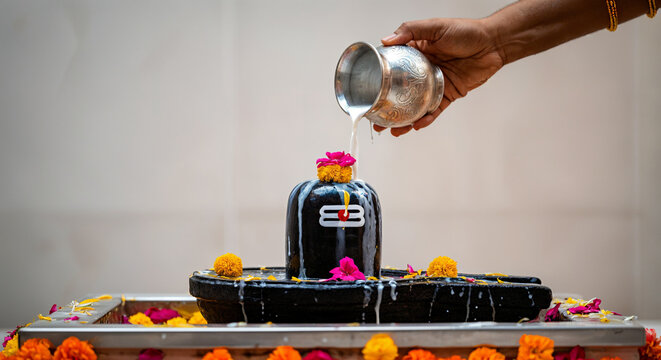“In almost every corner of India, from the smallest village shrine to grand temples, you’ll find the same sight — a stream of white milk flowing over the dark, smooth Shivling. The fragrance of incense fills the air, bells ring softly, and devotees watch with folded hands. This ritual isn’t new; it’s been part of our culture for thousands of years. But why milk? Why the Shivling? The answer is a beautiful blend of faith, stories, and even a bit of science.”
Mythological Roots:
Across India, it’s a common sight — devotees carrying pots of fresh milk to temples and slowly pouring it over the dark, smooth Shivling. For many, this is a sacred act of devotion. But in recent times, some have questioned the practice, suggesting that this milk could instead be given to the needy or to animals.
This raises a thought-provoking question: Why do we actually pour milk on the Shivling? Is it simply a religious habit, or does it have a deeper meaning? Did Lord Shiva himself ever ask for milk, or is there an ancient story behind it?
Indian mythology holds the answer. This age-old tradition is more than just a ritual — it’s tied to legends, spiritual symbolism, and even practical reasons that go back thousands of years. Let’s explore the real story and discover why this offering has been so important through the centuries.

This ritual started from an old story in Hindu scriptures called Samudra Manthan, which means the churning of the cosmic ocean. During this event, a dangerous poison called halahal came out, which could destroy the entire world.
To save the world, Lord Shiva drank the poison and held it in his throat, which turned blue, earning him the name Neelkanth (“the blue-throated one”). The intense heat of the poison was unbearable, so the gods and devotees offered cooling substances like water, honey, and especially milk to soothe him.
Thus, pouring milk on the Shivling became a symbolic way of offering comfort to Shiva, honoring his sacrifice for humanity.
Scientific Reasons:
Sadhguru– Milk is offered to the shivling because most of the lingas that you’re offering are stone lingas . And that stone linga, which is kept for worship – if you don’t abhishek it with milk or some kind of fat or oily material , eighther ghee or milk or something like this , it will crack. The linga will become brittle and crack over a period of time. So, periodically, you have to apply either oil, or ghee, or milk, or whatever you like. Something through which the stone can absorb fatty material so that there is integrity to the stone. So once you’re worshipping something, you don’t want it to crack up.
So the Question arises: It’s more like the maintenance.
Sadhguru: It is a certain maintenance. And also, it makes the linga – if it is properly consecrated, it’ll reverberate better if it remains wet. See, if you apply oil or ghee, or even milk, the fat of the milk, the linga remains wet all the time. As I said earlier, you have to keep your body wet to receive. And similarly linga has to be wet for it to exude this. So one simple way of keeping it wet is, soak it in oil, or ghee, or honey, or milk. All these things which will keep it wet for a long period of time. If I pour water, that also is being done, it will remain for ten minutes and then it’ll dry up. But if I pour milk, it stays wet for months on end. Because the fat has entered the pores in the rock.



